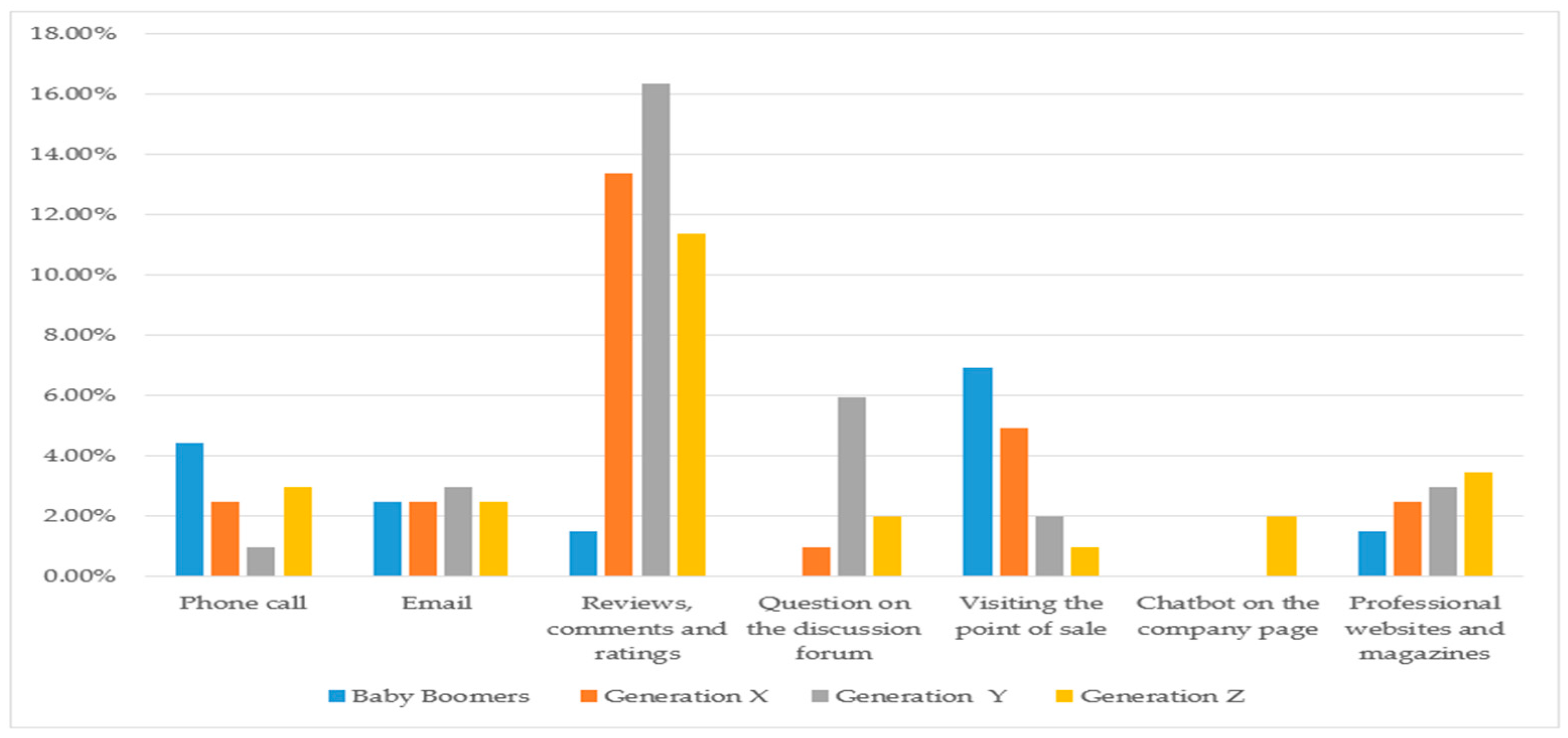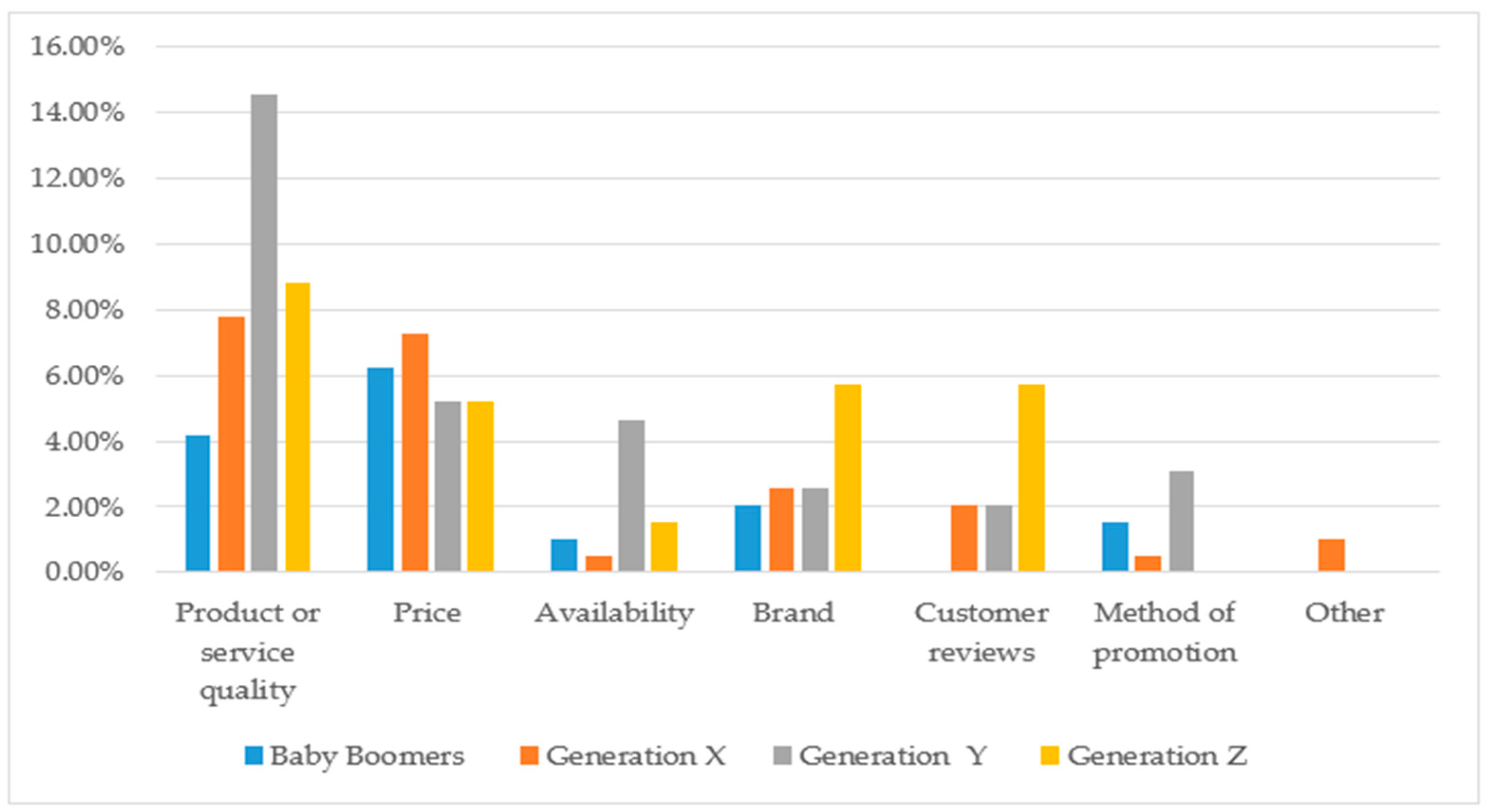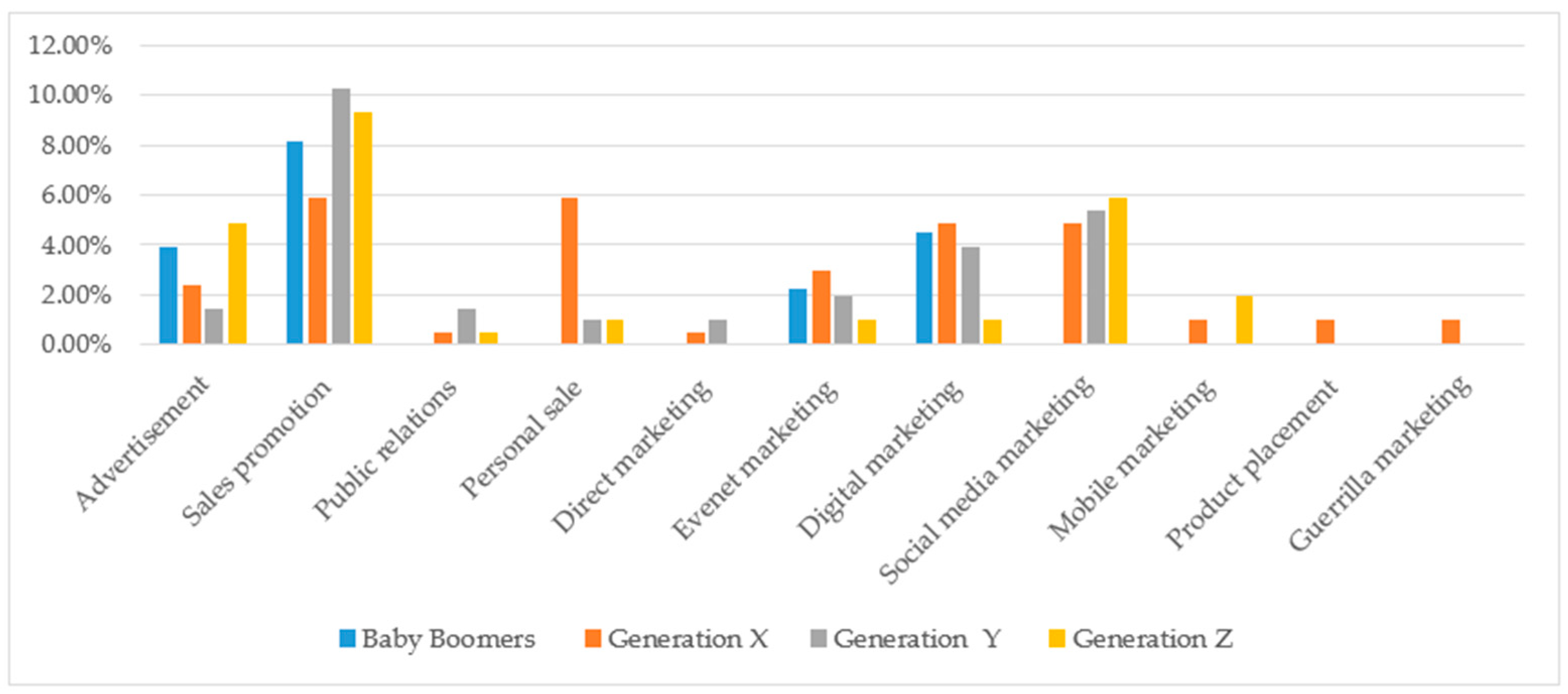Preferences of Generations of Customers in Slovakia in the Field of Marketing Communication and Their Impact on Consumer Behaviour
Abstract
:1. Introduction
2. Literature Review
3. Results
3.1. Research Question 1: Which Marketing Communication Tools Most Motivate Customers from Different Generations to Purchase a Product?
3.2. Research Question 2: Which Factors Most Influence the Purchasing Decisions of Customers from Different Generations?
3.3. Research Question 3: What Method of Communication Do Individual Generations Prefer?
4. Materials and Methods
- Which of the following marketing tools can motivate you the most to purchase a product?
- What are your main criteria when choosing products or services?
- Which of the following communication methods would you use if you needed to obtain information about a product?
- Which marketing communication tools most motivate customers from different generations to purchase a product?
- Which factors most influence the purchasing decisions of customers from different generations?
- What mode of communication do individual generations prefer?
5. Discussion
6. Conclusions
Author Contributions
Funding
Institutional Review Board Statement
Informed Consent Statement
Data Availability Statement
Acknowledgments
Conflicts of Interest
References
- Alakkas, Abdullah A., Vivek, Mohinder Paul, Mohammed Kamalun Nabi, and Mohammed Arshad Khan. 2022. Corporate social responsibility and firm-based brand equity: The moderating effect of marketing communication and brand identity. Sustainability 14: 6033. [Google Scholar] [CrossRef]
- Assael, Henry. 1995. Consumer Behavior and Marketing Action, 5th ed. Cincinnati: South-Western College Publishing. ISBN 978-8131500361. [Google Scholar]
- Bejtkovský, Jiří. 2016. The Employees of Baby Boomers Generation, Generation X, Generation Y and Generation Z in Selected Czech Corporations as Conceivers of Development and Competitiveness in their Corporation. Journal of Competitiveness 8: 105–23. [Google Scholar] [CrossRef]
- Bergh, Den Van. Joeri, and Mattias Behrer. 2010. How Cool Brands Stay Hot. Brno: Bizbooks. 248p, ISBN 978-80-265-0002-5. [Google Scholar]
- Bristow, Jennie. 2019. Stop Mugging Grandma: The ‘Generation Wars’ and Why Boomer Blaming Won’t Solve Anything. New Haven: Yale University Press. [Google Scholar]
- Consumer Trends Report. 2022. U.S. Consumer Trends Report. Available online: https://offers.hubspot.com/2022-consumer-trends-report-download (accessed on 12 May 2023).
- Costanza, David P., Jesica Michelle Badger, Rebecca L. Fraser, Jamie Severt, and Paul Gade. 2012. Generational differences in work-related attitudes: A meta-analysis. Journal of Business and Psychology 27: 375–94. [Google Scholar] [CrossRef]
- Čvirik, Marián. 2018. Selected characteristics of generation Y on the labor market. Economy and Society: Scientific Journal Bratislava: University of Economics in Bratislava 8: 105–23. [Google Scholar]
- Datacube. 2022. Age Structure of the Slovak Population. Available online: https://datacube.statistics.sk/#!/view/sk/VBD_SLOVSTAT/om2023rs/v_om2023rs_00_00_00_sk (accessed on 20 February 2024).
- Deloitte. 2023. Gen Z and Millennial Survey. Available online: https://www.deloitte.com/global/en/issues/work/content/genzmillennialsurvey.html (accessed on 21 June 2023).
- Duffy, Bobby. 2021. The Generation Myth: Why When You’re Born Matters Less Than You Think. Paris: Hachette UK. [Google Scholar]
- Egerová, Dana, Lenka Komárková, and Jiří Kutlák. 2021. Generation Y and Generation Z Employment Expectations: A Generational Cohort Comparative Study from Two Countries. E&M Economics and Management 24: 93–109. [Google Scholar] [CrossRef]
- Engel, James F., Roger D. Blackwell, and David T. Kollat. 1978. Consumer Behavior, 3rd ed. Oak Brook: Dryden Press. ISBN 978-0030211089. [Google Scholar]
- Frye, William D., Soonhwa Kang, Chang Huh, and Myong Jae M. J. Lee. 2020. What factors influence Generation Y’s employee retention in the hospitality industry? An internal marketing approach. International Journal of Hospitality Management 85: 102352. [Google Scholar] [CrossRef]
- GenZ Report Findings. 2022. Meet Gen Z: The Social Generation. Available online: https://www.oliverwymanforum.com/content/dam/oliver-wyman/ow-forum/template-scripts/a-gen-z/pdf/A-Gen-Z-Report.pdf (accessed on 25 May 2023).
- Hamdani, Nizar Alam, Intan Permana, Sukma Nugraha, and Galih Abdul Fatah Maulani. 2020. Nostalgic Marketing: A Study on Baby Boomers Generation. Paper presented at International Conference on Management, Accounting, and Economy (ICMAE 2020), Jakarta, Indonesia, February 13–14; Amsterdam: Atlantis Press, pp. 381–84. [Google Scholar]
- Hanuláková, Eva. 2021. Marketing Tools, Strategies, People and Trends. Bratislava: Walters Kluwer Publishing House. 363p, ISBN 978-80-571-0438-4. [Google Scholar]
- Howard, John A., and Jagdish N. Sheth. 1969. The Theory of Buyer Behavior. New York: John Wiley, pp. 12–15. [Google Scholar]
- Ingelhart, Ronald. 1977. The Silent Revolution. In Changing Values and Political Style among Western Publics. Princeton: Princeton University Press. [Google Scholar]
- Khayru, Rafadi Khan. 2021. Opinions about consumer behaviour during the COVID-19 pandemic. Journal of Social Science Studies (JOS3) 1: 31–36. [Google Scholar] [CrossRef]
- Kotler, Philip, and Gary Armstrong. 2019. Marketing: An Introduction. Praha: Publishing House Grada Publishing, p. 835s. ISBN 978-0-273-71395-1. [Google Scholar]
- Kotler, Philip, and Kevin Keller. 2019. Marketing Management. Praha: Grada Publishing, p. 816s. ISBN 978-80-247-4150-5. [Google Scholar]
- Lissitsa, Sabina, and Tal Laor. 2021. Baby Boomers, Generation X and Generation Y: Identifying Generational Differences in Effects of Personality Traits in On-Demand Radio Use. Technology in Society. Ari’el: Ariel University. ISSN 0160-791X. [Google Scholar] [CrossRef]
- Munsch, Alison. 2021. Millennial and generation Z digital marketing communication and advertising effectiveness: A qualitative exploration. Journal of Global Scholars of Marketing Science 31: 10–29. [Google Scholar] [CrossRef]
- Pattuglia, Simonetta, and Sara Amoroso. 2023. Generational Cohorts’ Reactions: Analysing the Impact of Brand Authenticity on Consumer Behaviour. International Journal of Business Analytics (IJBAN) 10: 1–15. [Google Scholar] [CrossRef]
- Pekovic, Sanja, and Sylvie Rolland. 2020. Recipes for achieving customer loyalty: A qualitative comparative analysis of the dimensions of customer experience. Journal of Retailing and Consumer Services 56: 102171. [Google Scholar] [CrossRef]
- Přikrylová, Jana. 2019. Modern Marketing Communication. Prague: Grada Publishing. 344p, ISBN 978-80-271-0787-2. [Google Scholar]
- Reidl, Andreas. 2012. The Senior Customer of the Future. Prague: BizBooks Publishing House. 256p, ISBN 978-8026500186. [Google Scholar]
- Rogers, Everett M. 1995. Diffusion of Innovations. New York: The Free Press, p. 12. [Google Scholar]
- Roth-Cohen, Osnat. 2022. Are you talking to me? Generation X, Y, Z responses to mobile advertising. Convergence: The International Journal of Research into New Media Technology 28: 761–80. [Google Scholar] [CrossRef]
- Seberíni, Andrea. 2021. Psychology of the Market. Prague: Publishing House of Matej Bel University in Banská Bystrica. 263p, ISBN 978-80-557-1896-5. [Google Scholar]
- Seemiler, Corey, and Meghan Grace. 2018. Generation Z. London: Publishing House Routledge, p. 348s. ISBN 978-1-13833-731-2. [Google Scholar]
- Singh, Prakash, Lokesh Arora, and Abdulaziz Choudhry. 2022. Consumer Behavior in the Service Industry: An Integrative Literature Review and Research Agenda. Sustainability 15: 250. [Google Scholar] [CrossRef]
- Smolka, Samuel. 2019. Characteristics of generations of Slovak consumers. Marketing science & inspirations: Scientific magazine focused on marketing and marketing management. Bratislava: Comenius University in Bratislava 14: 2–11. [Google Scholar]
- Tversky, Amos, and Daniel Kahneman. 2002. Judgment under uncertainty: Heuristics and biases. In Foundations of Cognitive Psychology: Core Readings. Edited by Daniel Levitin. Cambridge: MIT Press, pp. 585–600. [Google Scholar]
- Twenge, Jean M. 2018. Have smartphones destroyed a generation? The Atlantic, September 2017. [Google Scholar]
- Twenge, Jean M. 2023. Generations: The Real Differences Between Gen Z, Millennials, Gen X, Boomers, and Silents—And What They Mean for America’s Future. London: Publishing House Atria Books, p. 560s. ISBN 978-1-98218-161-1. [Google Scholar]



| Autor | Name of Generation | Time Range |
|---|---|---|
| Lissitsa Laor | Baby Boomers | 1946–1965 |
| Generation Y | 1966–1980 | |
| Generation Z | 1981–1994 | |
| Generation Z | 1994–present | |
| J. Bejtkovský | Baby Boomers | 1946–1964 |
| Generation X | 1965–1976 | |
| Generation Y | 1977–1995 | |
| Generation Z | 1996–present | |
| S. Smolka | Generation X | 1966–1976 |
| Generation Y | 1977–1995 | |
| Generation Z | 1996–2012 | |
| M. Čvirik | Greatest Generation | 1901–1924 |
| Silent Generation | 1925–1945 | |
| Baby Boomers | 1946–1964 | |
| Generation X | 1965–1979 | |
| Generation Y | 1980–1994 | |
| Generation Z | 1995–2009 | |
| Generation Alfa | 2010–present |
| Generational Cohort | Time Range |
|---|---|
| Baby Boomers | 1946–1960 |
| Generation X | 1961–1980 |
| Generation Y | 1981–1995 |
| Generation Z | 1996–2010 |
| Generation Cohort | Absolute Frequency | Relative Frequency |
|---|---|---|
| Baby Boomers | 1,132,446 | 26.86% |
| Generation X | 1,159,851 | 27.53% |
| Generation Y | 1,101,447 | 26.12% |
| Generation Z | 821,706 | 19.49% |
| Sum | 4,215,450 | 100% |
| Generation Cohort | Absolute Frequency | Relative Frequency |
|---|---|---|
| Baby Boomers | 36 | 17.65% |
| Generation X | 62 | 30.39% |
| Generation Y | 52 | 26.47% |
| Generation Z | 52 | 25.49% |
| Sum | 204 | 100% |
Disclaimer/Publisher’s Note: The statements, opinions and data contained in all publications are solely those of the individual author(s) and contributor(s) and not of MDPI and/or the editor(s). MDPI and/or the editor(s) disclaim responsibility for any injury to people or property resulting from any ideas, methods, instructions or products referred to in the content. |
© 2024 by the authors. Licensee MDPI, Basel, Switzerland. This article is an open access article distributed under the terms and conditions of the Creative Commons Attribution (CC BY) license (https://creativecommons.org/licenses/by/4.0/).
Share and Cite
Cagala, M.; Babčanová, D. Preferences of Generations of Customers in Slovakia in the Field of Marketing Communication and Their Impact on Consumer Behaviour. Adm. Sci. 2024, 14, 224. https://doi.org/10.3390/admsci14090224
Cagala M, Babčanová D. Preferences of Generations of Customers in Slovakia in the Field of Marketing Communication and Their Impact on Consumer Behaviour. Administrative Sciences. 2024; 14(9):224. https://doi.org/10.3390/admsci14090224
Chicago/Turabian StyleCagala, Matúš, and Dagmar Babčanová. 2024. "Preferences of Generations of Customers in Slovakia in the Field of Marketing Communication and Their Impact on Consumer Behaviour" Administrative Sciences 14, no. 9: 224. https://doi.org/10.3390/admsci14090224





